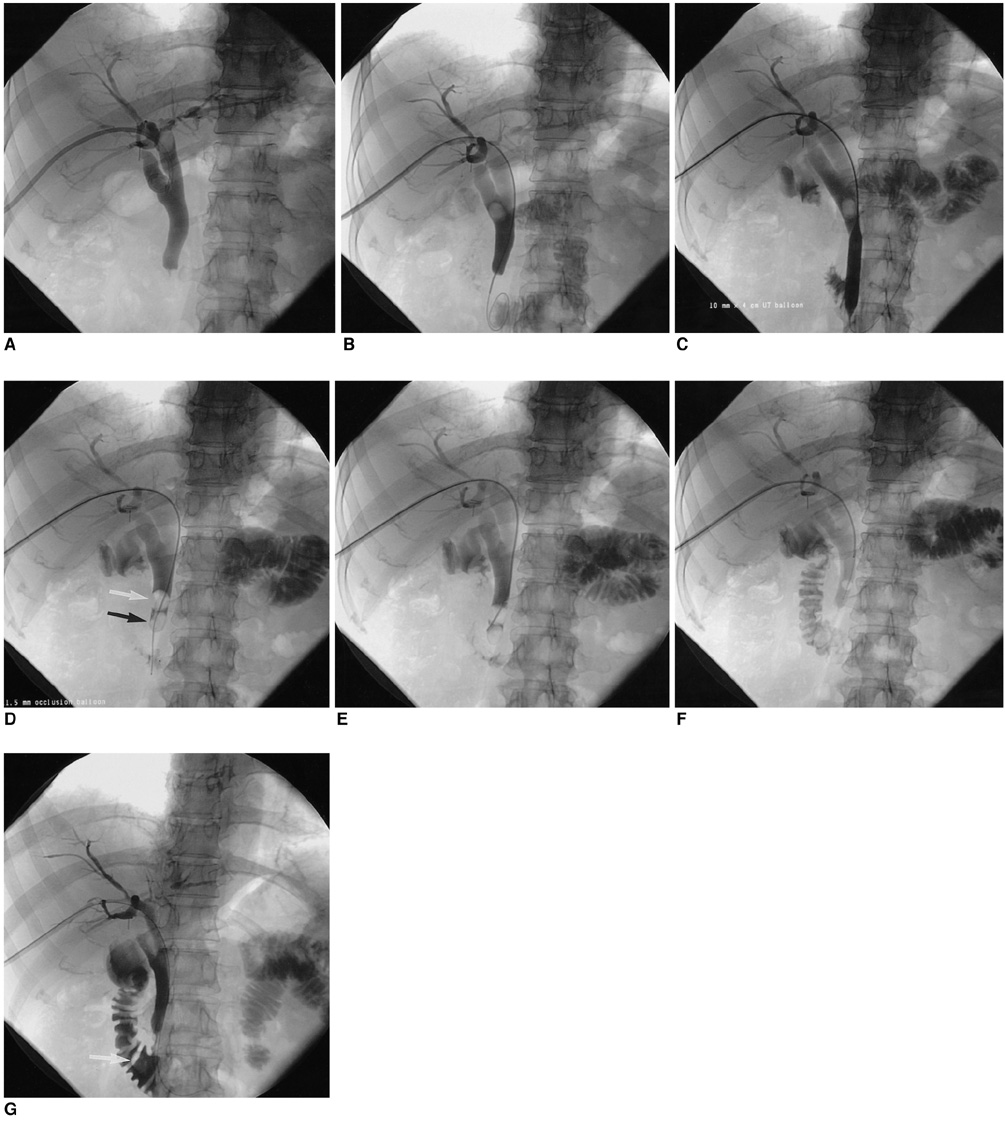Korean J Radiol.
2005 Dec;6(4):235-240. 10.3348/kjr.2005.6.4.235.
Percutaneous Treatment of Extrahepatic Bile Duct Stones Assisted by Balloon Sphincteroplasty and Occlusion Balloon
- Affiliations
-
- 1Department of Diagnostic Radiology, Konyang University Hospital, Korea. mdazzi70@yahoo.co.kr
- 2Department of Gastroenterology, Konyang University Hospital, Korea.
- KMID: 1777281
- DOI: http://doi.org/10.3348/kjr.2005.6.4.235
Abstract
OBJECTIVE
To describe the technical feasibility and usefulness of extrahepatic biliary stone removal by balloon sphincteroplasty and occlusion balloon pushing. MATERIALS AND METHODS: Fifteen patients with extrahepatic bile duct stones were included in this study. Endoscopic stone removal was not successful in 13 patients, and two patients refused the procedure due to endoscopy phobia. At first, all patients underwent percutaneous transhepatic biliary drainage (PTBD). A few days later, through the PTBD route, balloon assisted dilatation for common bile duct (CBD) sphincter was performed, and then the stones were pushed into the duodenum using an 11.5 mm occlusion balloon. Success rate, reason for failure, and complications associated with the procedure were evaluated. RESULTS: Eight patients had one stone, five patients had two stones, and two patients had more than five stones. The procedure was successful in 13 patients (13/15). In 12 of the patients, all stones were removed in the first trial. In one patient, residual stones were discovered on follow-up cholangiography, and were subsequently removed in the second trial. Technical failure occurred in two patients. Both of these patients had severely dilated CBD and multiple stones with various sizes. Ten patients complained of pain in the right upper quadrant and epigastrium of the abdomen immediately following the procedure, but there were no significant procedure-related complications such as bleeding or pancreatitis. CONCLUSION: Percutaneous extrahepatic biliary stone removal by balloon sphincteroplasty and subsequent stone pushing with occlusion balloon is an effective, safe, and technically feasible procedure which can be used as an alternative method in patients when endoscopic extrahepatic biliary stone removal was not successful.
MeSH Terms
Figure
Cited by 1 articles
-
Usefulness of Percutaneous Transhepatic Cholangioscopic Lithotomy for Removal of Difficult Common Bile Duct Stones
Jae Hyung Lee, Hyung Wook Kim, Dae Hwan Kang, Cheol Woong Choi, Su Bum Park, Suk Hun Kim, Ung Bae Jeon
Clin Endosc. 2013;46(1):65-70. doi: 10.5946/ce.2013.46.1.65.
Reference
-
1. Gil S, de la Iglesia P, Verdu JF, de Espana F, Arenas J, Irurzun J. Effectiveness and safety of balloon dilation of the papilla and the use of an occlusion balloon for clearance of bile duct calculi. AJR Am J Roentgenol. 2000. 174:1455–1460.2. Garcia-Vila JH, Redondo-Ibanez M, Diaz-Ramon C. Balloon sphincteroplasty and transpapillary elimination of bile duct stones: 10 years' experience. AJR Am J Roentgenol. 2004. 182:1451–1458.3. Lauri A, Horton RC, Davidson BR, Burroughs AK, Dooley JS. Endoscopic extraction of bile duct stones: management related to stone size. Gut. 1993. 34:1718–1721.4. Binmoeller KF, Schafer TW. Endoscopic management of bile duct stones. J Clin Gastroenterol. 2001. 32:106–118.5. Arnold JC, Benz C, Martin WR, Adamek HE, Riemann JF. Endoscopic papillary balloon dilation vs. sphincterotomy for removal of common bile duct stones: a prospective randomized pilot study. Endoscopy. 2001. 33:563–567.6. Garcia-Garcia L, Lanciego C. Percutaneous treatment of biliary stones: sphincteroplasty and occlusion balloon for the clearance of bile duct calculi. AJR Am J Roentgenol. 2004. 182:663–670.7. Lin CK, Lai KH, Chan HH, Tsai WL, Wang EM, Wei MC, et al. Endoscopic balloon dilatation is a safe method in the management of common bile duct stones. Dig Liver Dis. 2004. 36:68–72.8. Burhenne HJ. Garland lecture: percutaneous extraction of retained biliary tract stones - 661 patients. AJR Am J Roentgenol. 1980. 134:889–898.9. Garrow DG. The removal of retained biliary tract stones: report of 105 cases. Br J Radiol. 1977. 50:777–781.10. Burhenne HJ. Complications of non-operative extraction of retained common duct stones. Am J Surg. 1976. 131:260–265.11. Stokes KR, Clouse ME. Biliary duct stones: percutaneous transhepatic removal. Cardiovasc Intervent Radiol. 1990. 13:240–244.12. Clouse ME, Stokes KR, Lee RGL, Falchuk KR. Bile duct stones: percutaneous transhepatic removal. Radiology. 1986. 160:525–529.13. Stokes KR, Falchuk KR, Clouse ME. Biliary duct stones: update on 54 cases after percutaneous transhepatic removal. Radiology. 1989. 170:999–1001.14. Park JH, Choi BI, Han MC, Sung KB, Choo IW, Kim CW. Percutaneous removal of residual intrahepatic stones. Radiology. 1987. 163:619–623.15. Harris VJ, Sherman S, Trerotola SO, Snidow JJ, Johnson MS, Lehman GA. Complex biliary stones: treatment with a small choledochoscope and laser lithotripsy. Radiology. 1996. 199:71–77.
- Full Text Links
- Actions
-
Cited
- CITED
-
- Close
- Share
- Similar articles
-
- Endoscopic Treatment of Gallstone Diseases
- Percutaneous Biliary Stones Removal Using Balloon Sphincteroplasty and Hydraulic Pressure as the Primary Therapeutic Method
- PTPBD for Managing Extrahepatic Bile Duct Stones in Patients with Failed or Contraindicated ERCP
- Concurrent Yellow-to-white and Black Extrahepatic Bile Duct Stones
- Endoscopic Balloon Sphincteroplasty without Sphincterotomy for Removal of Common Bile Duct Stones



